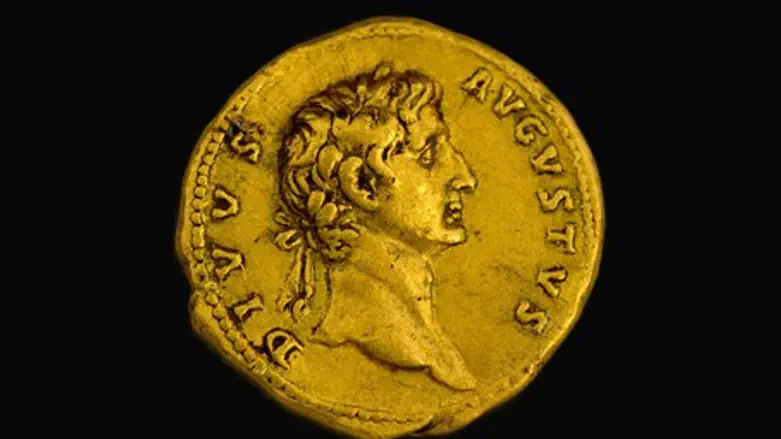
An Israeli woman hiking in the Galilee discovered an extremely rare, nearly 2,000-year-old gold coin - only the second such coin ever to be discovered.
The coin, dating back to the year 107 CE, bears the image of the Roman Emperor Augustus, and was unearthed by Laurie Rimon, a resident of Kibbutz Kfar Blum in northern Israel.
Rimon handed her extraordinary find to the Israel Antiquities Authority, and will be awarded a certificate of appreciation for good citizenship.
The only other such coin currently known to the world is located in the famous British Museum. According to the IAA, the coins were part of a series of nostalgic coins that Emperor Trajan minted and dedicated to the Roman emperors that ruled before him.
Rimon made the discovery when her group of hikers arrived at an archaeological site. Noticing something shining in the grass, Rimon picked up the object and quickly realized it was an ancient gold coin.
The group’s guide, Irit Zuk-Kovacsi contacted the Israel Antiquities Authority with the help of archaeologist and veteran tour guide Dr Motti Aviam, and within two hours an IAA representative joined the group of hikers in the field. Laurie turned the rare find over to him admitting, “It was not easy parting with the coin. After all, it is not every day one discovers such an amazing object, but I hope I will see it displayed in a museum in the near future."

Nir Distelfeld, an inspector with the IAA Unit for the Prevention of Antiquities Robbery, praised her for her "exemplary civic behavior by handing this important coin over to the Antiquities Authority.
"This is an extraordinarily remarkable and surprising discovery. I believe that soon, thanks to Laurie, the public will be able to enjoy this rare find."
Distelfeld encouraged others to act similarly.
"It is important to know that when you find an archaeological artifact it is advisable to call IAA representatives to the location spot in the field. That way we can also gather the relevant archaeological and contextual information from the site"
According to Dr. Danny Syon, a senior numismatist at the Israel Antiquities Authority, “This coin, minted in Rome in 107 CE, is rare on a global level.
"On the reverse we have the symbols of the Roman legions next to the name of the ruler Trajan, and on the obverse – instead of an image of the emperor Trajan, as was usually the case, there is the portrait of the emperor “Augustus Deified”. This coin is part of a series of coins minted by Trajan as a tribute to the emperors that preceded him."
The coin may date back to the famous Bar Kochba rebellion, according to Dr. Donald T. Ariel, head curator of the coin department at the Israel Antiquities Authority.
"The coin may reflect the presence of the Roman army in the region some 2,000 years ago – possibly in the context of activity against Bar Kochba supporters in the Galilee – but it is very difficult to determine that on the basis of a single coin.
"Historical sources describing the period note that some Roman soldiers were paid a high salary of three gold coins, the equivalent of 75 silver coins, each payday. Because of their high monetary value soldiers were unable to purchase goods in the market with gold coins, as the merchants could not provide change for them."
Similar bronze and silver coins with minted by Emperor Trajan have been previously discovered, Dr. Ariel added, but "his gold coins are extremely rare. So far, only two other gold coins of this emperor have been registered in the State Treasures, one from Givat Shaul near Jerusalem, and the other from the Qiryat Gat region and the details on both of them are different to those that appear on the rare coin that Laurie found."